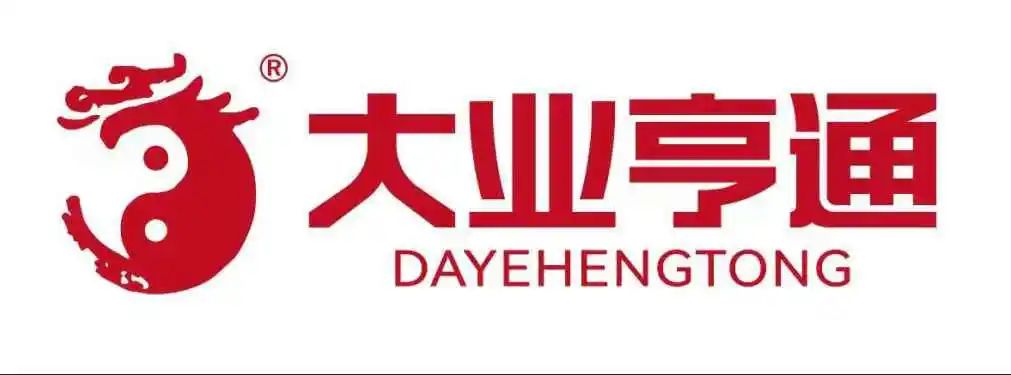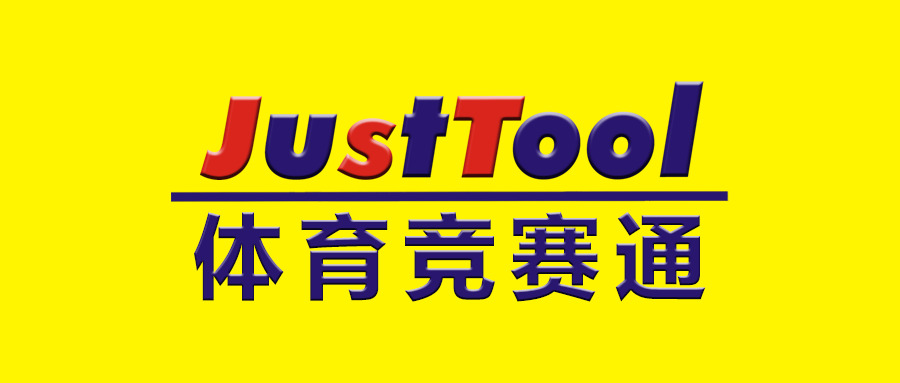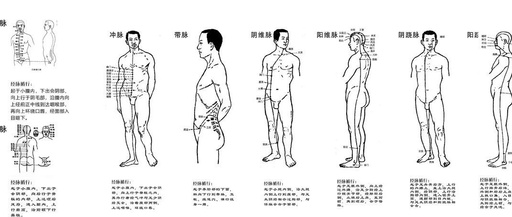The fitness Qigong, Baduanjin, is loved and pursued by the masses due to its simple movements, ease of practice, and noticeable effects. The author believes that the deeper reason for its popularity is closely related to the health principles of Traditional Chinese Medicine (TCM). Guiding Qi and the body is one of the characteristics of Baduanjin, which achieves health benefits through physical practice. The Eight Extraordinary Meridians have been revered by health practitioners throughout history, and their underlying health value cannot be ignored, as the movements, intentions, and mental methods of Baduanjin are closely related to them. The author attempts to discuss the health principles behind the popularity of Baduanjin from this perspective.
1. Overview of the Eight Extraordinary Meridians
The “Huangdi Neijing” has recorded the Eight Extraordinary Meridians, and the “Nanjing” further explains: “The meridians have eight extraordinary meridians, which are not confined to the twelve regular meridians. Why? Because there are Yangwei, Yinwei, Yangqiao, Yinqiao, Chong, Du, Ren, and Dai meridians. All these eight meridians are not confined to the regular meridians, hence they are called the Eight Extraordinary Meridians.” The Eight Extraordinary Meridians can connect the twelve regular meridians and also regulate the accumulation and infiltration of Qi and blood in the twelve regular meridians. Li Shizhen pointed out: “The regular meridians are like canals, while the extraordinary meridians are like lakes and marshes. When the meridians are prosperous, they overflow into the extraordinary meridians.” Traditional health practices place great emphasis on the flow and fullness of Qi and blood, while modern unhealthy lifestyles continuously deplete the Qi and blood of the twelve regular meridians, causing the accumulation of the Eight Extraordinary Meridians to flow into the twelve meridians, affecting human health.
The “Study of the Eight Extraordinary Meridians” states: “Yangwei governs the exterior of the body, while Yinwei governs the interior; Yangqiao governs the left and right Yang of the body, while Yinqiao governs the left and right Yin; Du governs the Yang at the back of the body, while Ren and Chong govern the Yin at the front; Dai meridian horizontally binds all meridians, governing the six directions.” This indicates that the functions of the Eight Extraordinary Meridians encompass the exterior and interior, left and right, front and back, and up and down.
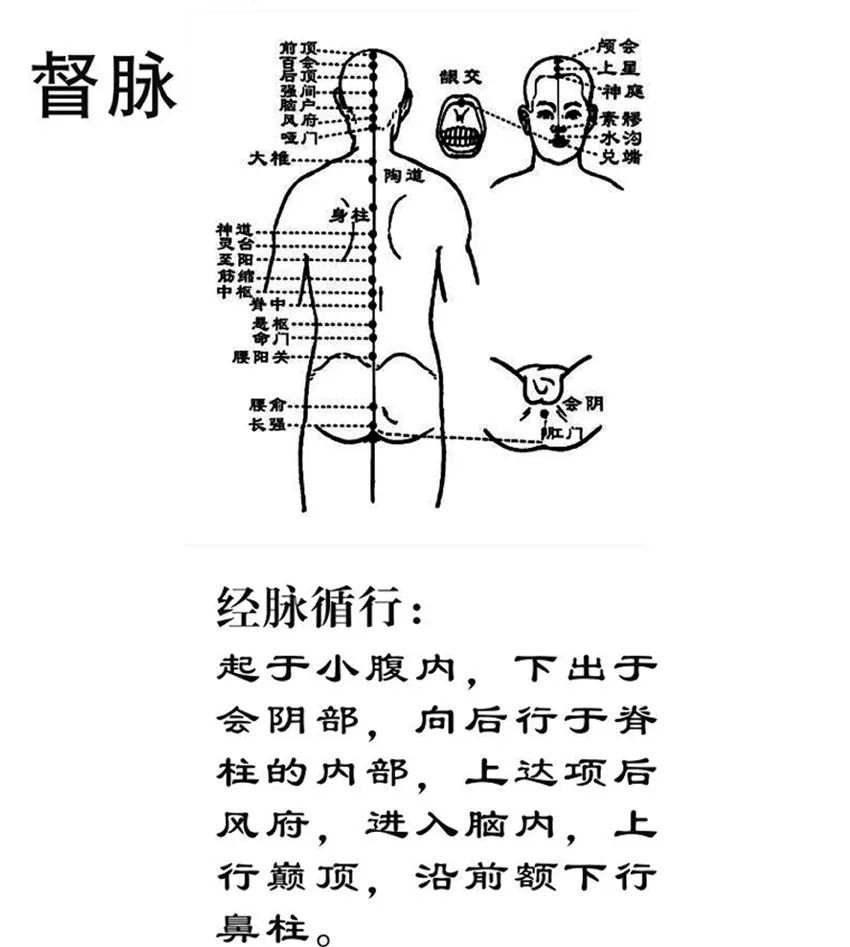
1. Du Meridian
The Du Meridian, meaning to supervise and command, has the function of overseeing all Yang meridians. The Du Meridian originates from the lower abdomen, diverges in the pelvic cavity, passes through the center of the pubic bone, and ascends from the perineum along the midline of the back to the Wind Mansion point, entering the brain, then along the top of the head down the center of the forehead to the philtrum, and encircles the lips to meet at the Gum Intersection point. The Du Meridian, Chong Meridian, and Ren Meridian all originate from the pelvic cavity, referred to as “one source and three divergences,” where the Du Meridian commands the Chong and Ren meridians and regulates the kidney Qi and spine. Therefore, the “Nanjing: Thirty Difficulties” states, “When there is a disease of the Du Meridian, the spine is strong and there is syncope.”
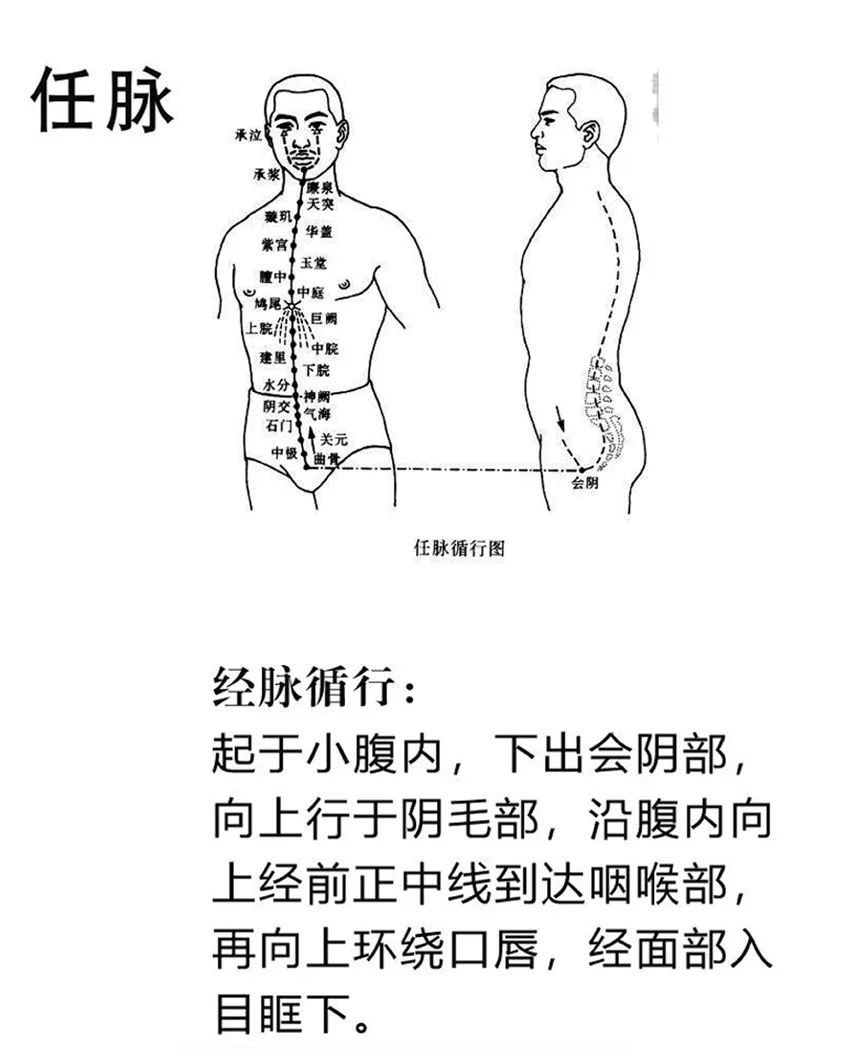
2. Ren Meridian
Ren means to nurture, and it is the foundation of life. Since the gathering points of the organs are mainly distributed along the Ren Meridian, it plays a key role in nurturing, gathering, and excreting metabolic products from the body. The Ren Meridian originates from the pelvic cavity, exits at the Middle Extreme point, descends to the perineum, ascends along the midline of the chest and abdomen, reaches the throat, and at the Chengjiang point, branches around the lips, meeting the Du Meridian at the Gum Intersection point, and then ascends to below the eyes. The “Nanjing” mentions that diseases of the Ren Meridian manifest as internal lumps, indicating dysfunction of excretion.
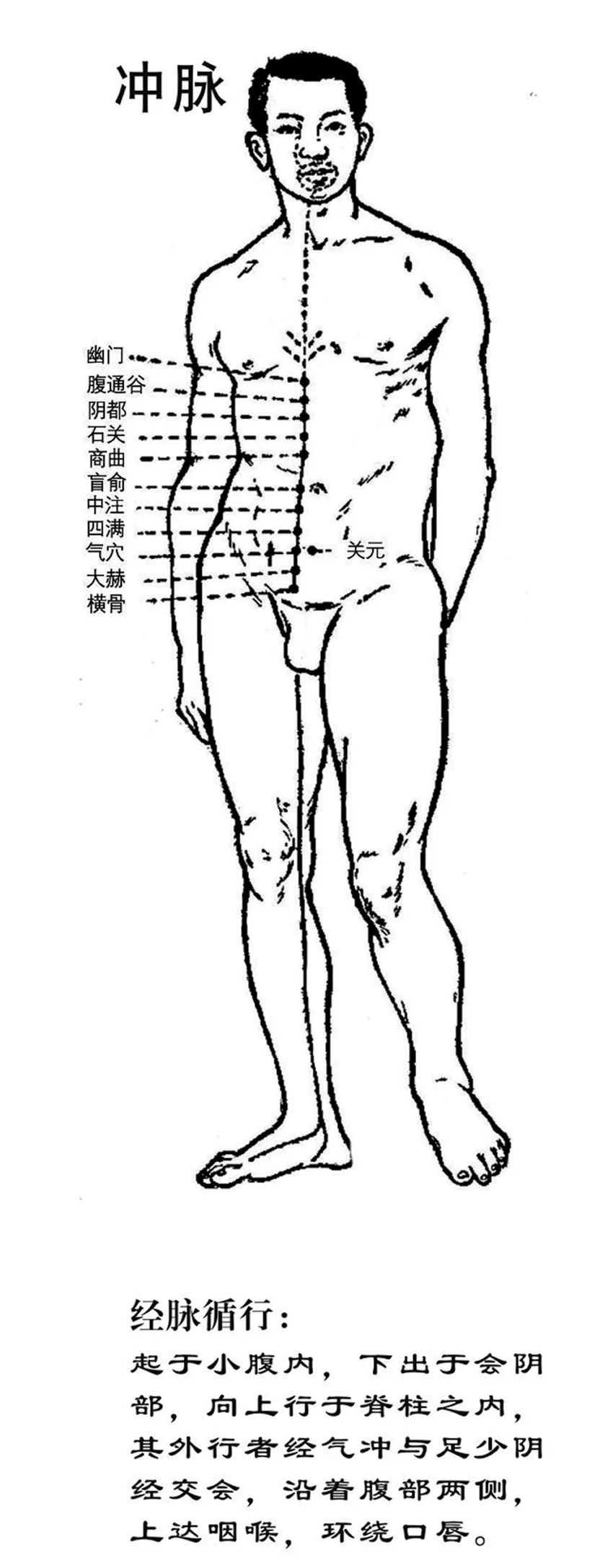
3. Chong Meridian
Chong means to connect and communicate, and it is also known as the “sea of the twelve meridians,” indicating that Qi and blood converge here. The Chong Meridian has an ascending branch and a descending branch: the ascending branch originates from the pelvic cavity, travels along the posterior wall of the abdominal cavity, ascends along the inner side of the spine, and intersects with the Dazhui point of the Bladder Meridian; the descending branch also originates from the pelvic cavity, descends to the perineum, intersects with the Ren Meridian, Du Meridian, and the Kidney Meridian, exits from the Qi Chong point of the Stomach Meridian, and descends along the inner thigh to the popliteal fossa, then travels along the inner side of the tibia to the foot. The pathway of the Chong Meridian shows its important role in regulating the Qi mechanism of the organs, male essence, and female menstruation. The Spleen and Stomach are the source of Qi and blood transformation, and are closely related to the Chong Meridian, which governs Qi and is the sea of blood, hence the saying “the Chong Meridian is subordinate to Yangming.”

4. Dai Meridian
Dai means to bind, and since the Dai Meridian runs horizontally, it has the function of binding and regulating all meridians. The Dai Meridian originates from the Zhangmen point, descends obliquely to the Dai point, encircles the body, runs parallel to the fourteen vertebrae, and at the Dai point, descends obliquely to the hip bone, intersecting with the Wushu point and Weidao point of the Gallbladder Meridian. The binding function of the Dai Meridian is mainly reflected in preventing the Qi of the various meridians from descending and sagging. Therefore, the “Miscellaneous Diseases Source” states: “The entire body is dependent on the Dai Meridian; if the Dai Meridian cannot maintain its Qi, all symptoms will sag down and not rise.”
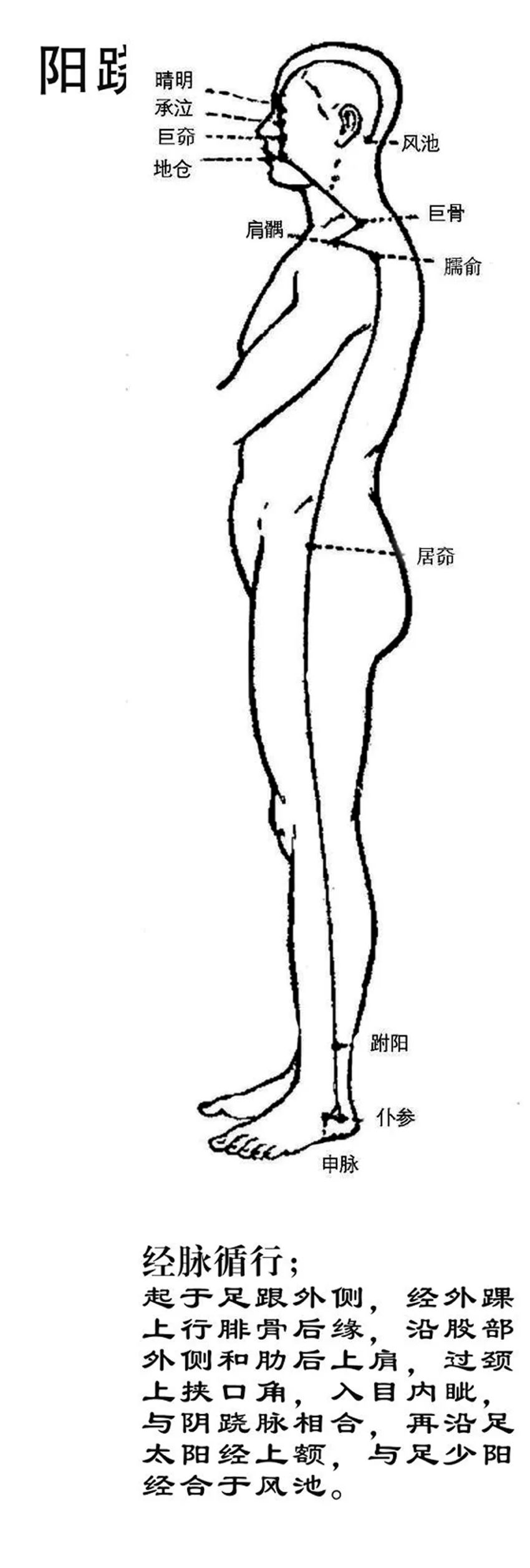
5. Yangqiao Meridian
Qiao means agility and strength, governing movement, and since it runs on the outer side, it is named Yangqiao, while the Yinqiao Meridian is the opposite. The Yangqiao Meridian is a branch of the Bladder Meridian, originating from the outer side of the heel, ascending from the outer ankle to the posterior edge of the fibula, along the outer thigh to the ribs, reaching the shoulder joint, and encircling the neck to ascend into the inner canthus of the eye, intersecting with the Bladder Meridian, Small Intestine Meridian, and Stomach Meridian at the Jingming point. The “Nanjing” states: “Yangqiao diseases manifest as Yin being slow and Yang being rapid,” indicating that abnormalities in the Yangqiao Meridian can lead to excessive Yang Qi and symptoms such as spasms in the areas it traverses. The “Huangdi Neijing” only calculates the length of the Yangqiao Meridian for men, highlighting its dominant role in male physiology.
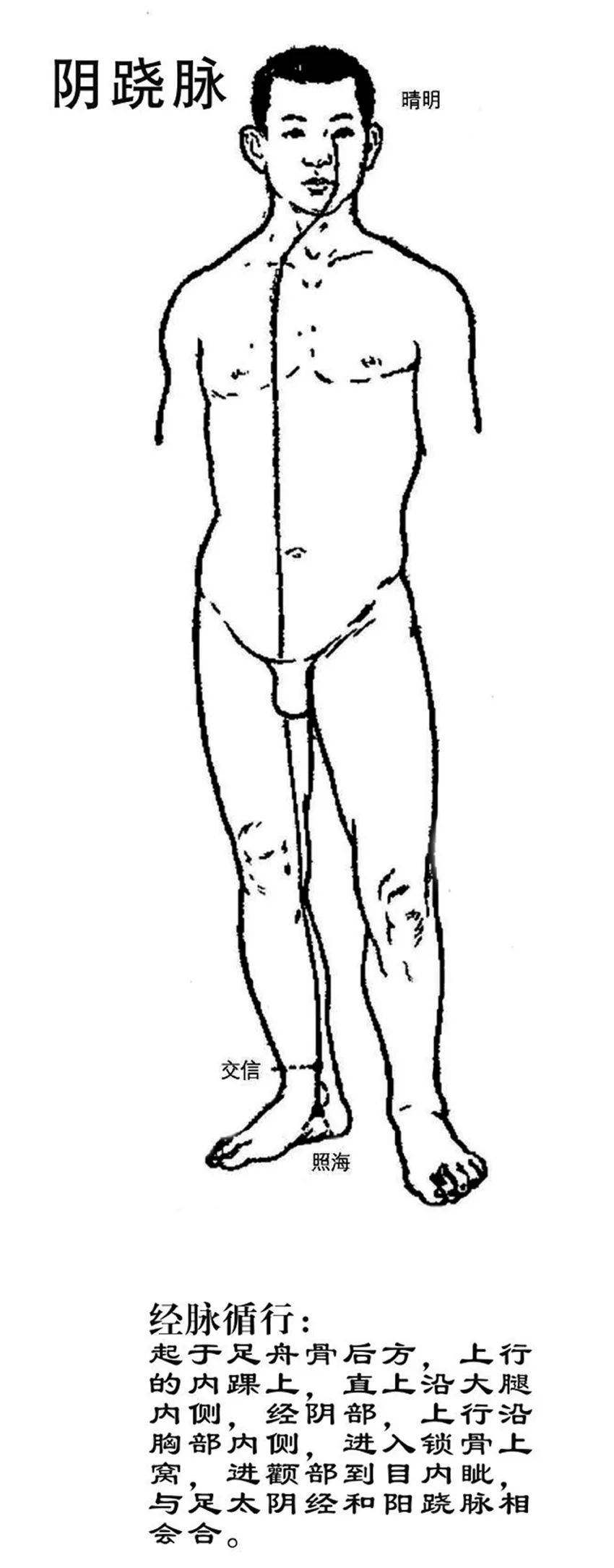
6. Yinqiao Meridian
The Yinqiao Meridian is a branch of the Kidney Meridian, originating from the inner side of the heel, ascending along the Zhaohai point of the Kidney Meridian to the inner thigh, passing through the perineum, and along the abdomen and chest to the Quepen point, branching out before the Ren point, reaching the throat, intersecting with the Chong Meridian, passing through the cheek, and reaching the inner canthus of the eye, where it intersects with the Hand and Foot Taiyang, Foot Yangming, and Yangqiao Meridians at the Jingming point. The Yinqiao Meridian governs the Yin of the body, and TCM believes that the left side governs blood and the right side governs Qi; therefore, diseases on the left side of the body are often related to blood, and treatment can be approached through the Yinqiao Meridian. Women are primarily concerned with blood, and the “Bencao Gangmu” explains the dominant role of the Yinqiao Meridian in female physiology, which aligns with the idea that women are primarily governed by the liver.
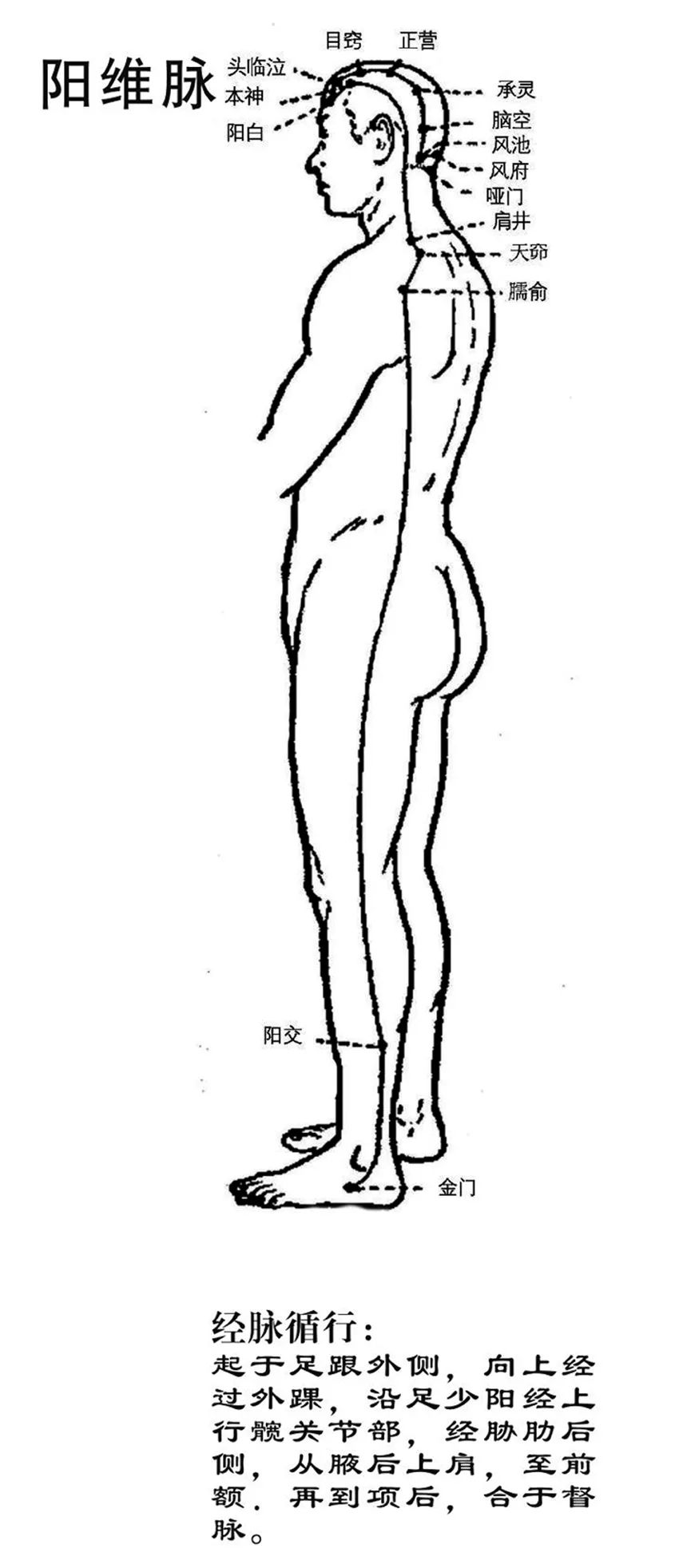
7. Yangwei Meridian
Wei means to maintain and connect, and the Yangwei Meridian regulates and controls the Yang meridians and external pathogens. The Yangwei Meridian originates from the outer side of the heel of the Bladder Meridian, passes through the outer ankle, and ascends along the Gallbladder Meridian to the hip joint, running along the posterior side of the ribs to the shoulder, reaching the Fengchi point behind the ear, and finally traversing the side of the head to the forehead. The “Nanjing” mentions that “Yangwei diseases manifest as suffering from cold and heat,” and Li Shizhen emphasizes that the Yangwei Meridian connects the three Yang meridians of the hands and feet, indicating that diseases caused by external pathogens can be treated through the Yangwei Meridian.
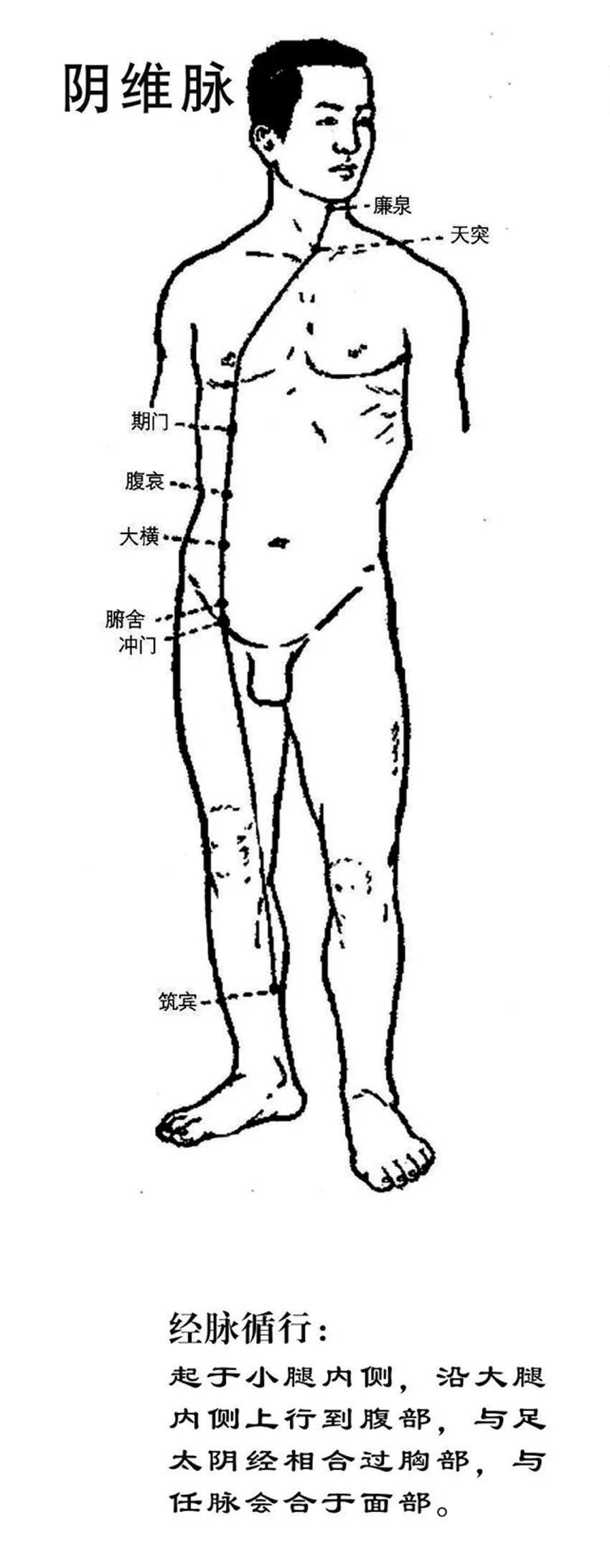
8. Yinwei Meridian
The Yinwei Meridian ascends along the inner side of the calf along the Kidney Meridian, intersects with the Spleen Meridian in the abdomen, travels to the chest and ribs to intersect with the Liver Meridian, and finally ascends to the throat to merge with the Ren Meridian. The “Nanjing” states that “Yinwei is related to Yin” and “Yinwei diseases manifest as heart pain,” emphasizing the connection of the Yinwei Meridian with internal injuries, where abnormalities in Qi and blood manifest as diseases of the heart and pericardium.
9. Eight Meridians Intersection Points
Among the twelve meridians, there are eight acupoints that connect with the Eight Extraordinary Meridians, known as the Eight Meridians Intersection Points, which are: the Houxi point of the Hand Taiyang Small Intestine Meridian – Du Meridian; the Lieque point of the Hand Taiyin Lung Meridian – Ren Meridian; the Gongsun point of the Foot Taiyin Spleen Meridian – Chong Meridian; the Zuliqiao point of the Foot Shaoyang Gallbladder Meridian – Dai Meridian; the Shenmai point of the Foot Taiyang Bladder Meridian – Yangqiao Meridian; the Zhaohai point of the Foot Shaoyin Kidney Meridian – Yinqiao Meridian; the Waiguan point of the Hand Shaoyang Sanjiao Meridian – Yangwei Meridian; and the Neiguan point of the Hand Jueyin Pericardium Meridian – Yinwei Meridian.
2. The Health Principles of the Eight Extraordinary Meridians and Baduanjin
1. Both Hands Supporting the Sky – Yangwei Meridian
Action: Both arms externally rotate and slightly lower; both arms internally rotate and lift up, palms facing up. By crossing the hands above, slowly applying force, and maintaining the stretch, it can stretch the Hand Shaoyang Sanjiao Meridian, and the internal and external rotation of the arms can also stimulate the Waiguan point.
This movement can benefit the Sanjiao by stimulating the Waiguan point of the Hand Shaoyang Sanjiao Meridian, as the Waiguan point connects to the Yangwei Meridian, thus facilitating the flow of the Yangwei Meridian. The symptoms of the Yangwei Meridian manifest as: “Yangwei diseases suffer from cold and heat,” which are symptoms caused by external pathogens. Baduanjin takes this as the first movement, reflecting the importance of enhancing righteous Qi to resist external pathogens for health.
2. Drawing the Bow Like Shooting a Hawk – Ren Meridian
Action: The right palm bends into a “claw,” pulling to the right in front of the shoulder (Zhongfu point – Yunmen point); the left palm forms a “8” shape, focusing on the left hand, with intention directed at the Shangyang point. Expanding the shoulders and chest can stimulate and regulate the Hand Taiyin Lung Meridian and Hand Yangming Large Intestine Meridian.
This movement places one hand in front of the shoulder at the lung meridian pathway, where the Zhongfu point is both the starting point of the Hand Taiyin Lung Meridian and the gathering point of the lung Qi; the other hand focuses on the Shangyang point, the well point and starting point of the Hand Yangming Large Intestine Meridian. Additionally, during the bow-drawing action, the exercise of the lung system is particularly emphasized, as the Lieque point, the connecting point of the lung meridian, not only communicates with the large intestine meridian but is also connected to the Ren Meridian. The “Lingshu: Meridians” states: “The Large Intestine is the Yangming meridian of the hand… intersecting at the philtrum, left to right, right to left, and above the nostrils.” The large intestine meridian intersects at the philtrum, which connects the Ren and Du meridians, thus the lung meridian, Ren Meridian, and large intestine meridian mutually influence each other.
3. Regulating the Spleen and Stomach Requires One Hand Lift – Chong Meridian
Action: The left arm is raised to the left upper side of the head, with force reaching the palm root, palm facing up; the right palm presses down to the right hip, with force reaching the palm root, palm facing down. The action of one palm facing up and the other facing down aligns with the physiological characteristics of the spleen rising and the stomach descending. The “Lingshu: Evil Guests” states: “If the spleen has evil, its Qi remains in both hips,” where one hand pressing on the hip has the effect of regulating the Qi mechanism of the spleen and stomach.
The Chong Meridian can regulate the Qi and blood of the twelve meridians, also known as the sea of the twelve meridians, and the spleen and stomach are the source of Qi and blood transformation, thus closely related to the regulation and control of Qi and blood. The Chong Meridian governs Qi, and its symptoms manifest as “reversed Qi and urgency,” indicating a disturbance in the Qi mechanism; the spleen and stomach are the pivot for the rise and fall of Qi, and both complement each other in regulating Qi.
The connecting points strengthen the relationship between the interior and exterior meridians, with the Foot Taiyin Spleen Meridian and Foot Yangming Stomach Meridian being interior-exterior meridians, and the Gongsun point of the spleen meridian enhances the connection between the spleen meridian, Chong Meridian, and stomach meridian. The prosperity and decline of the Chong Meridian directly affect women’s menstrual discharge, thus gynecological experts like Fu Qingzhu emphasize the importance of caring for the spleen and stomach in prescriptions.
4. Looking Back to Relieve Five Labors and Seven Injuries – Yinwei Meridian
Action: Both arms fully externally rotate, palms facing outward. This action significantly stretches and stimulates the three Yin meridians of the hands, especially the Hand Jueyin Pericardium Meridian, where the Neiguan point is fully opened during the external rotation and internal retraction process.
The Neiguan point is the connecting point of the Hand Jueyin Pericardium Meridian, a key point for treating internal injury-related diseases. This movement, with both arms fully rotating, forms a regulation pattern involving the Neiguan point, Hand Jueyin Pericardium Meridian, and Yinwei Meridian to alleviate the five labors and seven injuries.
5. Shaking the Head and Wiggling the Tail to Eliminate Heart Fire – Dai Meridian
Action: The body’s center of gravity shifts back to the right, the upper body tilts to the right, and the center of gravity shifts to the left while wiggling the tail. This action fully stretches the Dai Meridian point during the tail-wiggling, and stimulates the Dai Meridian when shifting left and right.
The “Clinical Guidelines for Medical Cases” states: “When there is damage above and below, treat the middle.” “Eliminating heart fire” indicates that this movement can regulate the heart and kidney not communicating, leading to symptoms of heart fire inflammation. The Dai Meridian is located at the midpoint of the body’s vertical axis, and the trajectory of the tail-wiggling action corresponds with the pathway of the Dai Meridian, facilitating the flow of Qi and blood in the Dai Meridian, allowing the heart fire and kidney water to return to their respective places.
6. Both Hands Grasping the Feet to Strengthen the Kidney and Lower Back – Yangqiao Meridian
Action: Both palms face inward, sliding down along both sides of the spine to the buttocks; then the upper body leans forward, and both palms continue to slide down along the back of the legs to the feet; raise the head, pausing slightly; and look forward and downward.
This movement, while bending the body, fully stimulates and stretches the meridians and tendons of the Bladder Meridian. Bending the body and repeatedly raising the head achieves the effect of warming the kidneys and Mingmen through the connection with the Bladder Meridian and Yangqiao Meridian. As previously mentioned, the Yangqiao Meridian is closely related to male physiological functions, and since the kidneys are fundamental for men, this movement is particularly important for males.
7. Clenching Fists and Staring to Increase Strength – Yinqiao Meridian
Action: Both palms are clenched and held at the waist, near the Zhangmen point, punching and staring. This movement aims to regulate the liver system, where the liver is represented by the clenching action, and the Zhangmen point is the gathering point of liver Qi and blood.
The Yinqiao Meridian governs lower limb movement and the opening and closing of the eyes, thus staring can stimulate the Yinqiao Meridian. This movement, through clenching fists and staring, along with gripping the ground with toes, exercises the liver system, where the liver is Yin, and the connection between Yin and Yang is reflected in the liver and kidney Yin, thus this movement exercises the liver and kidney through the Yinqiao Meridian. As previously mentioned, the Yinqiao Meridian plays a key role in female physiological functions, and since women are primarily governed by the liver, they can particularly appreciate the benefits of this movement during exercise.
8. Bouncing on the Heels to Eliminate All Diseases – Du Meridian
Action: The toes grip the ground, legs together, contracting the anus and abdomen, lifting the Baihui point; the heels drop, lightly shaking the ground. The contraction of the anus and lifting of the Baihui point are along the pathway of the Du Meridian.
This movement stimulates the spine and Du Meridian while bouncing on the heels, self-regulating the disorder of the spinal joints to find a balance; while lifting the heels, the contraction of the anus, with the Changqiang point being the starting point of the Du Meridian on the body surface, aims to facilitate the flow of the Du Meridian.
(Authors: Zhu Haoming, Su Yixu, Yan Xinghui)
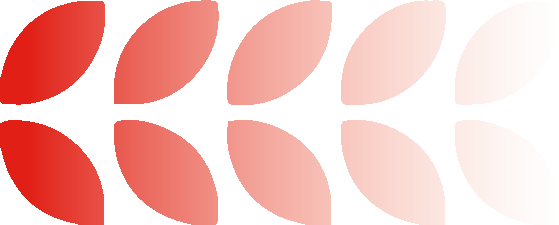
Strategic Partner of the Chinese Fitness Qigong Association
